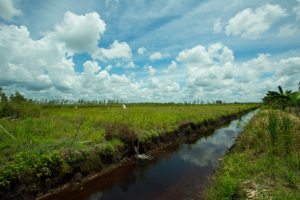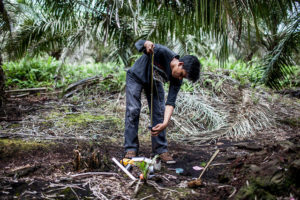
The Global Landscapes Forum (GLF): Peatlands Matter takes place on May 18 in Jakarta, Indonesia.
The significance of the conference is underscored by the need to reach a common understanding of problems and solutions around peatlands — key hotspots at the intersection of certain Sustainable Development Goals (SDGs), including food security, water and biodiversity — and of addressing climate change.
The GLF is an important forum for a program like FTA, which is not only a research program but a research for development program. Because of this, FTA works in the sphere of research, and beyond that in the sphere of influence, in order to affect the way stakeholders behave and adopt suitable solutions.
Working with stakeholders is also important to ensure the “legitimacy” of the research that FTA designs and implements, so users feel that the research and researchers have understood and accounted for their interests, values and concerns — necessary for successful uptake.
Read also: Strength in numbers: How the Global Landscapes Forum connects the land use community

Importantly, working with stakeholders is fundamental for issues where the nature of the problem (and related solutions) is not easily agreed upon. Peatlands are one such issue, as one cannot apply a single lens (be it the carbon lens, the local environment lens, the biodiversity lens or the livelihood lens) to understand the potential solutions.
That is why FTA and its partners are proud, once again, to be one of the key providers of knowledge at the GLF, namely for mutual understanding and action. At the Jakarta conference, this will feed into three debates on the “science behind peatlands”, set to be heard during the event’s discussion forums.
Fueling three debates
The first discussion forum, titled “Black gold” for climate mitigation? The rediscovered carbon stocks in tropical wetlands and peatlands and hosted by the Center for International Forestry Research (CIFOR), looks at the latest tools for identifying and locating wetlands and peatlands, and reveals how scientists are reassessing carbon stocks.
Ahead of the conference, CIFOR produced a set of six briefs illustrating the science behind peatlands, all the result of research under FTA. The briefs point out that peatlands are the most threatened type of ecosystem, especially in Southeast Asia, due to agricultural development. Another publication, Managing peatlands in Indonesia: Challenges and opportunities for local and global communities, shows that the drainage of peat swamp forests and their conversion into agricultural land causes considerable and irreversible environmental, social and economic damage.
CIFOR has also published a new map that reveals more peat in the tropics, with “unprecedented extents and volumes […] three times the size of previous estimates, and mainly outside Asia.” It states that “South America appears as the main host of peat areas and volumes with Brazil at the top of the list, closely followed by Indonesia.” These publications address where peatland can be found, its characteristics, what can be done at a management level to protect it, and the human aspect relating to those who live on and around it.

A second debate at the GLF covers Peatland fires, haze and health, a session organized by UN Environment, raising awareness on the impacts of peatland fires on the climate and human health, and showcasing innovative tools for tracking, preventing and managing the impact of fire and haze events.
There is a need to support local governments and planning agencies in understanding the need for clear spatial planning for peat areas and identifying areas for planting and restoration. This discussion is informed by FTA’s work, and especially builds on the UK Department for International Development (DFID)-supported project with Indonesian and UK scientific partners on the political economy of fire and haze.
Third, the World Agroforestry Centre (ICRAF) holds People and peat: Livelihoods in context, focusing on livelihood options for local communities using a case study landscape in Jambi, Indonesia, as the starting point. The case looks at conflict resolution in forests.
ICRAF previously acted upon a request from farmer groups to help with “zonation management rights”, said the session’s moderator Ingrid Öborn and FTA scientist Meine van Noordwijk. They could therefore provide “on-demand help”, they explained, as they sought to “manage wet forests in ways relevant for people”. The session is expected to explore social aspects of the peatlands issue, including how local livelihoods can be secured in such areas.
A policy brief published by ICRAF, titled Agroforestry on peatlands: combining productive and protective functions as part of restoration, states that: “In order to control the use of fire and to avoid the deep drainage that is responsible for degradation, government commitments need to go beyond good intentions alone. Land-use solutions are needed that provide local livelihoods while keeping the peat profiles wet.”

FTA’s role in the GLF motto of “reaching 1 billion”
The GLF aims to reach 1 billion stakeholders to advance landscape approaches and address sustainable development challenges. This event will gather key stakeholders from around the world around on the issue of peatlands.
The role of FTA is to engage in debate and provide scientific evidence that sheds light on broad and complex issues, which integrate social, environmental, economic and governance elements.
Therefore, FTA’s goal at the GLF is to bring relevant, credible and legitimate results to the forum, which will contribute to the overall effectiveness of FTA’s research, for progress, mutual understanding and to change perspectives on the ground.
As applied at this GLF peatlands thematic event, FTA’s ambition to is to lay the groundwork for evidence-based, legitimate and effective debates, to enable agreements between stakeholders on solutions to be rolled out for the sustainable management of peatlands and to preserve this inestimable resource.
Click here to find out more about attending the GLF or watching the livestream.
By Vincent Gitz, Director of the CGIAR Research Program on Forests, Trees and Agroforestry.
This research forms part of the CGIAR Research Program on Forests, Trees and Agroforestry.











